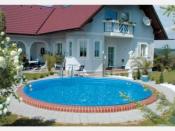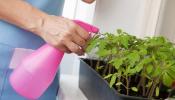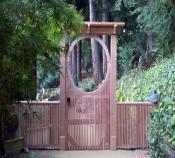Search
Login
Dry mixes in construction: bulk floors, primers, putties and plasters
Modern high-quality repair is impossible without perfect alignment of the surfaces of the floor, walls and ceiling. To help, for creating perfectly smooth surfaces, dry building mixes are offered on the building materials market.
Content
- Dry mix for bulk floors video
- How to calculate the required volume of the mixture
- Mixtures based on cement, on a gypsum basis or on a mixed binder? video
- The minimum and maximum thickness of the leveling layer
- Primer mixes
- Primer Primer
- How to apply a primer
- Putty: with what is friends, and with what not?
- How much time should pass before applying a leveling mixture to a cement-sand screed
Dry mix for bulk floors
For modern high-quality repairs, surfaces that are perfectly even are needed, since floor coverings appeared in the form of a laminate, parquet board.
Installation of such flooring requires very high quality substrates.
This pushed manufacturers to create thin-layer leveling mixtures.
Using such mixtures, you can easily remove small differences in height and get a perfectly smooth surface as opposed to a classic cement-based screed.
Using a cement-based screed it is impossible to create a perfectly even surface.
It is the bulk floor, already in a liquid state, that creates a horizontal surface.
In this case, the horizontal surface is maintained after hardening.
It should be noted that the bulk floor itself is very expensive and it must be used very sparingly, which is economically advantageous with a bulk floor thickness of 5-10 mm.
How to calculate the required volume of the mixture
Modern manufacturers of dry building mixes give information on the packaging of mixtures or put in an information leaflet.
It indicates the flow rate of the mixture for a certain layer thickness and the area of \u200b\u200bthe surface to be leveled.
The consumer must know the surface differences in height and knowing the specific consumption indicated in the information sheet - it will easily calculate the required amount of the mixture.
To the final figure you need to add 10-15% for losses.
Mixtures based on cement, on a gypsum basis or on a mixed binder?
Self-leveling floors are produced on a gypsum basis, on cement and on a mixed binder.
Bulk floors on a gypsum binder can only be used indoors, because gypsum is an air hardening binder.
When interacting with water, gypsum hardens, but retains good strength only in the air, and if moisture is constantly present, it quickly loses strength and collapses.
Cement-based flooring is allowed to be made indoors and outdoors, because cement interacts well with water and can harden both in air and in water.
The third building mixture consists of a mixture of cement and gypsum.
Such a composition quickly gains strength, is moisture resistant, but is intended only for indoor use.
The minimum and maximum thickness of the leveling layer
The minimum thickness of the leveling layer is 2 mm.
The maximum thickness depends on the flaws of your flooring, but with a layer above 100 mm. there is no point in aligning, since the load on the base and foundation increases very much, and besides, your floor will become golden.
So, with high differences, this issue needs to be addressed in a different way.
Primer mixes
All soils subdivided not by scope (floor, ceiling, walls), but by the type of base.
The primer is selected depending on the plaster mix.
There are universal surface primers - they can be used to prepare the base, as increasing adhesion, to even out absorbency.
Quite often, the question arises of determining the surface porosity.
If the surface is porous, then it absorbs moisture very intensively.
Weakly absorbing substrates, such as old tiles, are treated with the appropriate primer: use concrete - an asset with quartz filler.
Thus, a dense rough surface is formed, with the help of such soil, applying an adhesive composition, lay a new layer of tile directly on the old.
Primer Primer
Primer - primer is a painted primer.
This primer is good to use before applying color tinted color plasters.
Creating a colored plaster, create a furrowed texture, while cutting a layer of plaster to the base and if the base is gray, it will be visible through these furrows.
To exclude this defect, use a primer - primers of a color painted in the tone of the coating.
How to apply a primer
The primer can be applied in any way, using a roller or brush.
The surface must be primed before applying each composition and after applying each composition.
That is, they are primed before putty and after putty.
Primed before and after plastering.
It is good to use putty and primer of one company.
Experts advise the primer to be applied with a roller and in two layers, since if the base is porous, then one layer is not enough.
The use of a primer in front of paints and varnishes can save paints from 10 to 70%.
If the surface is pre-primed, then expensive paintwork materials are laid in a thin layer - thereby preserving your wallet.
Putty: with what is friends, and with what not?
Putty is not friendly with the tiles, so before laying the tiles putty surface does not make sense.
Otherwise, if you plaster, the tile adhesive will tear off this thin layer of plaster along with the tile.
Gypsum is not friendly with cement, i.e. gypsum substrates are incompatible with cement, as well as cement are incompatible with gypsum.
That is, if you are working with gypsum materials, such as gypsum plasters, use gypsum putties.
If you work with cement materials - use cement putties.
In the case of using gypsum plaster on cement putty, the cement interacts with gypsum and, as a result, the material is peeled off.
Gypsum materials can only be applied to cement substrates after priming.
How much time should pass before applying a leveling mixture to a cement-sand screed
Only 28 days after hardening does the cement-sand mixture acquire 70% strength.
If this period is not met, and ceramic tile is laid on the base, then it can be torn along with the screed.
Only after 28 days the base acquires the necessary strength and can resist all loads without deformation and destruction of the material.
If the screed was made on a plaster or mixed basis, then ripening is much faster.
You can check the quality of drying with a paper towel: it is left on the surface of the screed and if after a few hours the paper becomes wet, then the screed is not yet ready.





